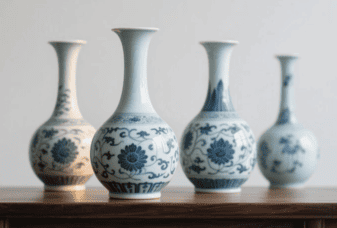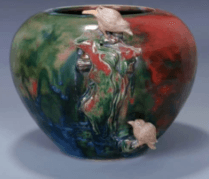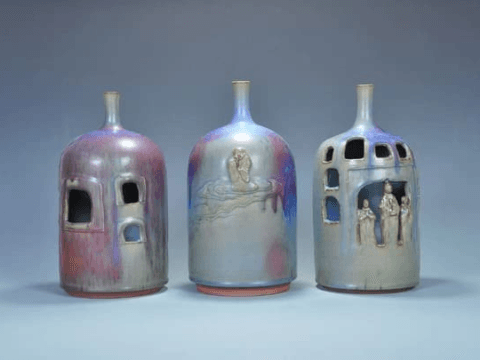Ming chenghua years of porcelain identification: details
“A Chenghua porcelain, ten years of official kiln work” – in the auction room, the Ming Chenghua years of porcelain repeatedly hit a record of 100 million yuan, and the authenticity of its identification is the focus of collectors competing for research.
2022 Hong Kong Sotheby’s autumn auction, a Chenghua blue and white twining lotus bowl sold at 230 million Hong Kong dollars, the bottom of the “Ming Chenghua years of production” six double line of the stroke of the paragraph, become the expert certification of the key evidence. These words between the square inches, in fact, hidden what the historical code?

First, the historical status of Chenghua porcelain and paragraph characteristics
As the pinnacle of the Ming dynasty kilns on behalf of the Chenghua porcelain with thin glaze, painting is famous for its exquisite.
According to the “Ming history – food and goods,” recorded in the reign of emperor chenghua 23 years, jingdezhen imperial kiln factory average annual production of less than a thousand, and more for the court reward, resulting in less than 400 pieces of authentic heirlooms, which with a clear chronicle of the more precious wares.
The six-character mark “Da Ming Chenghua nian zhi” mainly presents three forms:
The blue and white double-ringed mark: common in bowls and plates, the blue and white material is light and elegant, and the double-ringed lines are unevenly thick and thin, showing the characteristics of hand-painted.
Darkly engraved regular script mark: mostly used on monochrome glazed porcelain, the bamboo knife is used to engrave the writing on the body and then cover the glaze and fire it.
Seal-script mark in a square frame: only found on a few special wares, with strong and powerful strokes.
It is worth noting that the Chenghua mark never appeared “made” word, all see “Chenghua years made” are later imitation.
The National Palace Museum in Taipei Chenghua doucai chicken bowl cup of the paragraph research shows that the authentic font spacing sparse, strokes with a unique “sense of frustration”, this feature comes from the potter with a bald pen dipped in cobalt material when writing the natural traces.
Second, four-dimensional identification method to crack the imitation of the maze
In the face of endless imitations on the market, mastery of “shape, color, work, rhyme” four-dimensional identification method is crucial:

1. word shape comparison
Genuine use Pavilion Regular Script, the font structure has obvious characteristics of the era:
The second stroke of the character “大” is short and the closing stroke is slightly curved.
The “sun” part of the character “Ming” is wide at the top and narrow at the bottom, while the vertical hook of the “moon” part is upright.
The diagonal hook of the character “成” is like a curved bow, while the dot of the fifth stroke is close to the horizontal fold.
The character “制” has a curved vertical stroke next to the vertical knife, which is at an angle of 45° with the left part.
2. The color of the green material
Chenghua kilns used domestic equal green material, scientific testing shows that its cobalt oxide content of about 0.8%-1.2%. Under 20 times magnification, the authentic Qinghua mark can be seen in a cloudy halo, while the Qing dynasty imitations are more intensely blue due to the use of zhe or zhuming materials.
3. Tire and glaze relationship
Genuine part of the glaze shows glutinous rice luster, with 40 times microscope observation can be seen under the glaze bubble sparse, size distribution such as “morning star”. Although the modern high imitation can imitate the glaze texture, but often due to the firing temperature is too high resulting in dense and uniform bubbles.
4. Historical traces
Beijing Palace Museum Science and Technology Inspection Center has Chenghua blue and white palace bowl X-ray fluorescence analysis, found that the edge of the authentic paragraph there is a natural glaze phenomenon, which is the tire glaze contraction rate differences in the creation of a unique mark. Mechanical engraving often too neat edge, the lack of hand-written charm of the spirit.
Third, the evolution of the characteristics of the successive generations of imitation paragraph
Since the Zhengde years, Chenghua paragraph porcelain has become a hot spot for imitation, different periods of imitation of the paragraph has a flaw:
Jiajing imitation paragraph: long and thin font, “year” word the fourth stroke of the vertical painting is often beyond the horizontal painting
Kangxi imitation: blue color blue, paragraph peripheral double circle straight and even
Guangxu imitation: glaze greenish-white, font structure loose and powerless
Modern high imitation: the use of laser engraving technology, but the lack of ink and brush strokes at the beginning and end of the rhyme
2021 London Asian art week appeared in the “Chenghua blue and white Sanskrit cup” will be due to the paragraph in the “chemical” word apostrophe too straight, was judged to be Yongzheng period imitation, and finally sold at the price of the real 1/10. This warning collectors: “details determine the authenticity, avoid superstitious pulp”.
Fourth, the combination of scientific and technological means and traditional ophthalmology
With the development of detection technology, thermoluminescence dating and glaze aging trace analysis has become an important auxiliary means. Jingdezhen Institute of Ceramic Archaeology comparison experiments show that the authentic part of the glaze microstructure shows “caviar” aging, which is five hundred years of natural oxidation of the formation of the unique logo.
However, the famous connoisseur Mr. Sun Yingzhou put forward the “mark five see” principle (see the brushwork, see the structure, see the green material, see the glaze, see the tire bone) is still the identification of the fundamental. As he emphasized in the “Chenghua official kiln porcelain identification”: “imitators seek similarity and loss of charm, the real thing has its own royal temperament between the ink and brush”.
From the Taipei National Palace of the fighting color TianZi pot to the British Museum of blue and white anemone pattern palace bowl, those bearing the aesthetic ideals of the Ming dynasty of the paragraph, is still telling the world five hundred years ago the spirit of craftsmanship. By mastering these identification tips, one

